- Home
- Deepak Chopra
The Book of Secrets: Unlocking the Hidden Dimensions of Your Life Page 2
The Book of Secrets: Unlocking the Hidden Dimensions of Your Life Read online
Page 2
Scan the list of qualities again and take note of everything marked “not an option”: selfishness, refusing to communicate, living like an outcast, overconsumption, obsessive activity, and aggression. If our cells know not to behave in these ways, why do we? Why is greed good for us and yet spells destruction at the level of our cells, where greed is the basic mistake made by cancer cells? Why do we allow overconsumption to lead to an epidemic of obesity when our cells measure to the molecule how much fuel to consume? The very behavior that would kill our bodies in a day hasn’t been renounced by us as people. We are betraying our bodily wisdom, and worse, we are ignoring the model of a perfect spiritual life inside ourselves.
This book was not born out of a sense that people are spiritually weak and inadequate. It was born from a moment of crisis in my family that gave me new hope instead. My father died a few years ago when no one expected it. Still vigorous at eighty-one, he had spent that January day watching a new U.S. president being inaugurated. Retired from his long medical practice as a cardiologist, my father still kept a professional hand in, and he had spent that evening discussing medical cases with a circle of his students.
My mother, who was sleeping in a separate room because of poor health, didn’t hear Krishan go to bed. But after midnight, when she was still unable to sleep, he appeared at her door in his bedclothes, barely a dim outline in the darkness, and said that he was leaving. Immediately my mother knew what he meant. My father kissed her goodbye and said that he loved her. Then he padded quietly back to his room where only the night sounds of crickets, tropical birds, and Delhi traffic penetrated. He lay down, called to God three times, and died.
Our family was swept up in turmoil. My younger brother and I rushed to India from the United States as fast as we could, and within hours, having traditionally dressed my father’s body for the funeral and strewn it with marigolds, we carried it downstairs to the wailing of women mixed with sacred chanting. Not long after that, I was standing over a pile of ashes at the burning ghat by the river, performing the eldest son’s duty of smashing the remains of the skull with a stick to symbolically release the earthly bonds to the life my father had led.
I couldn’t escape the feeling that he had completely and utterly disappeared, this man who had been the most loved person in my life and the last one I thought of losing so soon. But the fact that he had passed with such clear, calm awareness kept all of us from feeling the deepest pangs of grief. Although I was certain Krishan Chopra was gone in the form of the body and personality I knew, my emotions couldn’t rest until I articulated, in every detail possible, what he had become. The mystery was changing him from one state to another, and I realized that the same transformation is happening in myself and in everyone. We are all held together and we all dissolve according to mystery, nothing else.
Instead of investigating the mystery of life as an intimate part of ourselves, we’ve been acting as if it doesn’t exist. Everyone has suffered for this neglect, and more suffering, perhaps on an unheard-of scale, is looming over the horizon. My father departed from a world sunk in the depths of gloom. When the evening news comes on tonight, trouble will be breaking out everywhere, as it always is, and the answers being offered won’t be anywhere close to the wisdom of a single cell. Many people lose heart and withdraw from the challenge of so much suffering. Others assume that they must leave where they are and find something they do not yet have—a new relationship, a new job, a new religion or teacher—before they can feel alive again.
Would the cells in your body accept such defeatist logic? If where you are isn’t good enough, then love and healing and God will remain forever out of reach. After generations of life spent in chaos, are we ready to let the mystery save us now? Is there any other way?
CHANGING YOUR REALITY TO ACCOMMODATE THE FIRST SECRET
Each secret will be matched with an exercise to allow you to apply it to yourself. Reading about a secret has an effect at the level of thinking; the level of feeling and the level of doing remain untouched. All three have to merge before you are actually changing your personal reality.
The first secret is to let your body’s wisdom point the way. Today, write down the ten qualities of this wisdom mentioned earlier, and for each one, think of a way you could live that quality. Note it down and make this your guide for the day. You can pursue one quality per day or list them all and try to follow as many as you can. Don’t strain for self-improvement; don’t write from a sense that you are weak or inadequate. The purpose here is to extend your body’s comfort zone into behavior and feeling. Let your words express aspirations near your heart that make you feel like your true self. For example:
Higher purpose: I am here to serve. I am here to inspire. I am here to love. I am here to live my truth.
Communion: I will appreciate someone who doesn’t know that I feel that way. I will overlook the tension and be friendly to someone who has ignored me. I will express at least one feeling that has made me feel guilty or embarrassed.
Awareness: I will spend ten minutes observing instead of speaking. I will sit quietly by myself just to sense how my body feels. If someone irritates me, I will ask myself what I really feel beneath the anger—and I won’t stop paying attention until the anger is gone.
Acceptance: I will spend five minutes thinking about the best qualities of someone I really dislike. I will read about a group that I consider totally intolerant and try to see the world as they do. I will look in the mirror and describe myself exactly as if I were the perfect mother or father I wish I had had (beginning with the sentence “How beautiful you are in my eyes”).
Creativity: I will imagine five things I could do that my family would never expect—and then I will do at least one of them. I will outline a novel based on my life (every incident will be true, but no one would ever guess that I am the hero). I will invent something in my mind that the world desperately needs.
Being: I will spend half an hour in a peaceful place doing nothing except feeling what it is like to exist. I will lie outstretched on the grass and feel the earth languidly revolving under me. I will take in three breaths and let them out as gently as possible.
Efficiency: I will let at least two things out of my control and see what happens. I will gaze at a rose and reflect on whether I could make it open faster or more beautifully than it already does—then I will ask if my life has blossomed this efficiently. I will lie in a quiet place by the ocean, or with a tape of the sea, and breathe in its rhythms.
Bonding: When I catch myself looking away from someone, I will remember to look into the person’s eyes. I will bestow a loving gaze on someone I have taken for granted. I will express sympathy to someone who needs it, preferably a stranger.
Giving: I will buy lunch and give it to someone in need on the street (or I will go to a café and eat lunch with the person). I will compliment someone for a quality that I know the individual values in him- or herself. I will give my children as much of my undivided time today as they want.
Immortality: I will read a scripture about the soul and the promise of life after death. I will write down five things I want my life to be remembered for. I will sit and silently experience the gap between breathing in and breathing out, feeling the eternal in the present moment.
Exercise #2: Accident or Intelligence?
Every secret in this book goes back to the existence of an invisible intelligence that operates beneath the visible surface of life. The mystery of life is an expression not of random accidents but of one intelligence that exists everywhere. Is such an intelligence believable, or should you continue to believe in random events and chance causation?
Read the following unexplained facts; then check Yes or No if you already knew that such mysteries exist.
Yes No Desert birds living by the Grand Canyon bury thousands of pine nuts in widely scattered locations along the canyon rim. They retrieve this stored food during the winter, returning precisely to the nuts each one buried and find
ing them under a deep layer of snow.
Yes No Salmon born in a small stream that feeds the Columbia River in the Pacific Northwest swim out to sea. After several years spent roaming vast distances of ocean, they return to spawn at the precise place where they were born, never winding up in the wrong stream.
Yes No Little children from several countries were read to in Japanese; afterward they were asked to pick whether they had just heard some nonsense words or a lovely Japanese poem. The children from Japan all got the answer right, but so did significantly more than half the children from other countries who had never listened to a word of Japanese in their lives.
Yes No Identical twins hundreds or thousands of miles apart have immediately sensed the moment when their sibling died in an accident.
Yes No Fireflies in Indonesia numbering in the millions are able to synchronize their flashes over an area of several square miles.
Yes No In Africa, certain trees that are being overforaged can signal other trees miles away to increase the tannin in their leaves, a chemical that makes them inedible to foraging animals. The distant trees receive the message and alter their chemistry accordingly.
Yes No Twins separated at birth have met for the first time years later, only to find that they’ve each married a woman with the same first name in the same year and now have the same number of children.
Yes No Mother albatrosses returning to a nesting site with food in their beaks immediately locate their chicks among hundreds of thousands of identical offspring on a crowded beach.
Yes No Once a year at the full moon several million horseshoe crabs emerge together on one beach to mate. They have answered the same call, from depths of the ocean where no light ever penetrates.
Yes No When air molecules cause your eardrum to quiver no differently from a cymbal being hit with a stick, you hear a voice that you recognize speaking words you understand.
Yes No On their own, sodium and chlorine are deadly poisons. When they combine as salt, they form the most basic chemical in support of life.
Yes No To read this sentence, several million neurons in your cerebral cortex had to form an instantaneous pattern that is completely original and never appeared before in your life.
There is no grade for this exercise, but keep it at hand until you finish this book. Then return to see if your beliefs have changed enough that you can give an explanation based on the spiritual secrets being discussed.
Secret #2
THE WORLD IS IN YOU
TO SOLVE THE MYSTERY OF LIFE requires only one commandment: Live like a cell. But we don’t, and the reason is not hard to find. We have our own way of doing things. Our cells are fueled by the same oxygen and glucose that fueled amoebas two billion years ago, but we are attracted by high-fat, sugary, more or less frivolous fad foods. Our cells cooperate with each other along the same lines set down by evolution in tree ferns of the Cretaceous period, but we find a new enemy somewhere in the world every decade, perhaps every year or month. We all have a similar tale to tell of deviations from the precise, complete, and almost perfect wisdom that our bodies follow.
Our wayward lapses point to a much larger pattern. To get back to the cell’s wisdom, each of us needs to see that we are living the aftereffects of someone else’s old choices. We were taught to follow a set of habits and beliefs that totally disregard the mystery of life. These beliefs are contained one inside the other like nested boxes:
There is a material world.
The material world is full of things, events, and people.
I am one of those people, and my status is no higher than that of anyone else.
To find out who I am, I must explore the material world.
This set of beliefs is binding. It allows no room for soul-searching, or even for the soul itself. Why bring the mystery of life into a system that already knows what is real? But as convincing as the material world looks, to the great embarrassment of modern science, no one has been able to prove that it is real. Ordinary people don’t focus on science, so this glaring problem is not well known. Yet any neurologist will assure you that the brain offers no proof that the outside world really exists and many hints that it doesn’t.
All the brain does, in fact, is to receive continuous signals about the body’s state of chemical balance, temperature, and oxygen consumption, along with a crackling stream of nerve impulses. This mass of raw data starts out as chemical bursts with attached electrical charges. These blips run up and down a tangled web of spidery nerve cells, and once a signal reaches the brain, like a runner from the edge of the Empire bringing a message to Rome, the cortex assembles the raw data into even more complex arrangements of electrical and chemical blips.
The cortex doesn’t inform us about this never-ending data processing, which is all that is happening inside gray matter. Instead, the cortex tells us about the world—it allows us to perceive sights, sounds, tastes, smells, and textures—the whole array of creation. The brain has pulled an enormous trick on us, a remarkable sleight of hand, because there is no direct connection between the body’s raw data and our subjective sense of an outside world.
For all anyone knows, the entire outside world could be a dream. When I’m in bed having a dream, I see a world of events just as vivid as the waking world (for most of us, the other four senses are scattered unevenly throughout our dreams, but some dreamers can touch, taste, hear, and smell as accurately as they can while awake). But when I open my eyes in the morning, I know that these vivid events were all produced inside my head. I’d never make the mistake of falling for this trick because I already assume that dreams aren’t real.
So does my brain dedicate one apparatus to making the dream world and another to the waking world? No, it doesn’t. In terms of cerebral function, the dream mechanism doesn’t flick off when I wake up. The same visual cortex in the rear of my skull allows me to see an object—a tree, a face, the sky—whether I am seeing it in memory, in a dream, in a photo, or standing before me. The locations of brain cell activity shift slightly from one to the other, which is why I can distinguish among a dream, a photo, and the real thing, yet the same fundamental process is constantly taking place. I am manufacturing a tree, a face, or the sky from what is actually a random tangle of spidery nerves shooting bursts of chemicals and electrical charges in my brain and all around my body. No matter how hard I try, I will never find a single pattern of chemicals and charges in the shape of a tree, a face, or any other shape. There is just a fire-storm of electrochemical activity.
This embarrassing problem—that there is no way to prove the existence of an outside world—undermines the entire basis of materialism. Thus we arrive at the second spiritual secret: You are not in the world; the world is in you.
The only reason that rocks are solid is that the brain registers a flurry of electrical signals as touch; the only reason the sun shines is that the brain registers another flurry of electrical signals as sight. There is no sunlight in my brain, whose interior remains as dark as a limestone cavern no matter how bright it is outside.
Having said that the whole world is created in me, I immediately realize that you could say the same thing. Are you in my dream or am I in yours—or are we all trapped in some bizarre combination of each other’s personal version of events? To me, this isn’t a problem but the very heart of spirituality. Everyone is a creator. The mystery of how all these individual viewpoints somehow mesh, so that your world and mine can harmonize, is the very thing that makes people seek spiritual answers. For there is no doubt that reality is full of conflict but also full of harmony. It is very liberating to realize that as creators we generate every aspect, good or bad, of our experience. In this way, each of us is the center of creation.
People used to find these ideas very natural. Centuries ago the doctrine of one reality occupied center stage in spiritual life. Religions and peoples and traditions varied wildly, but there was universal agreement that the world is a seamless creation imbued with one intel
ligence, one creative design. Monotheism called the one reality God; India called it Brahman; China called it the Tao. By any name, every person existed within this infinite intelligence, and whatever we did on our own was part of creation’s grand design. A person didn’t have to become a spiritual seeker to find the one reality. Everybody’s life already fit into it. The creator permeated each particle of creation equally, and the same divine spark animated life in all its forms.
Today we’d call this view mystical because it deals in invisible things. But if our ancestors had had access to microscopes, wouldn’t they have seen concrete proof of their mysticism in the way cells behave? To believe in an all-embracing reality places everyone at the center of existence. The mystical symbol for this was a circle with a dot in the center, signifying that each individual (the dot) was secretly infinite (the circle). This is like the tiny cell whose central dot of DNA connects it to billions of years of evolution.
But is the concept of one reality mystical at all? Outside my window in winter I can usually spy at least one chrysalis dangling from a branch. Inside it a caterpillar has turned into a pupa that will emerge in spring as a butterfly. We are all familiar with this metamorphosis, having witnessed it as children (or by reading Eric Carle’s The Very Hungry Caterpillar). But what goes on invisibly inside the chrysalis remains deeply mysterious. The caterpillar’s organs and tissues dissolve into an amorphous, souplike state, only to reconstitute into the structure of a butterfly’s body that bears no resemblance to a caterpillar at all.

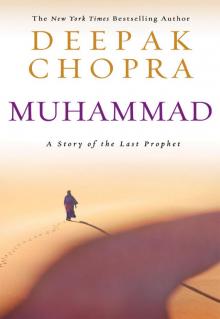 Muhammad: A Story of the Last Prophet
Muhammad: A Story of the Last Prophet Buddha
Buddha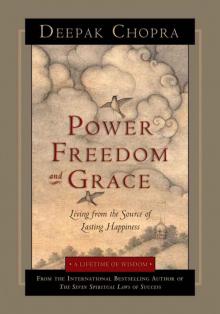 Power, Freedom, and Grace
Power, Freedom, and Grace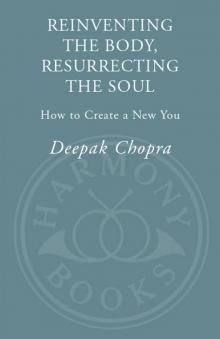 Reinventing the Body, Resurrecting the Soul: How to Create a New You
Reinventing the Body, Resurrecting the Soul: How to Create a New You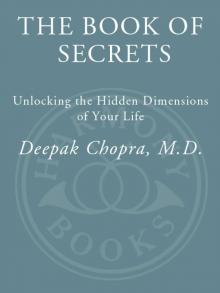 The Book of Secrets: Unlocking the Hidden Dimensions of Your Life
The Book of Secrets: Unlocking the Hidden Dimensions of Your Life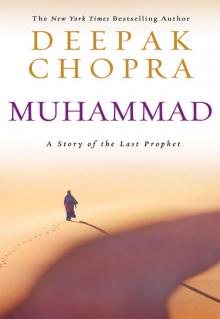 Muhammad
Muhammad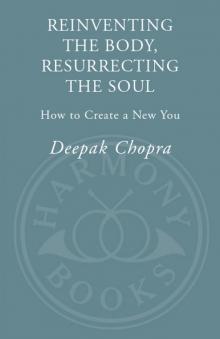 Reinventing the Body, Resurrecting the Soul
Reinventing the Body, Resurrecting the Soul